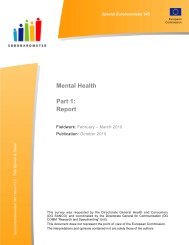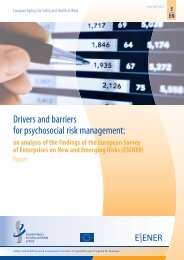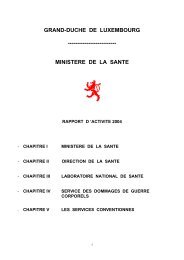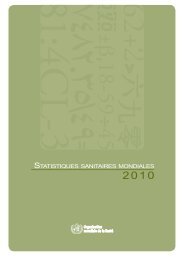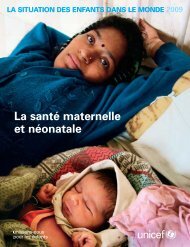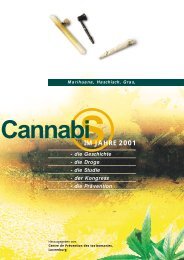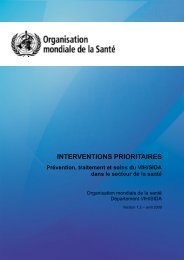Global Tuberculosis Control 2010 - Florida Department of Health
Global Tuberculosis Control 2010 - Florida Department of Health
Global Tuberculosis Control 2010 - Florida Department of Health
You also want an ePaper? Increase the reach of your titles
YUMPU automatically turns print PDFs into web optimized ePapers that Google loves.
the estimated number <strong>of</strong> incident cases that occurred in<br />
the same year.<br />
Estimates <strong>of</strong> the incidence <strong>of</strong> sputum smear-positive<br />
pulmonary TB and the related CDR for these cases are<br />
not published in this report. There are several reasons<br />
for this, which are summarized in the main part <strong>of</strong> the<br />
report ( ). Among the reasons noted in this box<br />
are the findings and associated recommendations from<br />
the 18-month expert review <strong>of</strong> methods used to estimate<br />
disease burden described in above, and<br />
associated updates to methods used to estimate disease<br />
burden that have been applied in a series <strong>of</strong> regional<br />
workshops and country missions (). A fuller<br />
explanation is provided here.<br />
In regional workshops and country missions, the<br />
starting point for estimates <strong>of</strong> the incidence <strong>of</strong> TB was<br />
an estimate <strong>of</strong> the CDR for all forms <strong>of</strong> TB. This was<br />
because, for many countries, estimates <strong>of</strong> the incidence<br />
<strong>of</strong> all forms <strong>of</strong> TB are used to produce indirect estimates<br />
<strong>of</strong> TB mortality and TB prevalence (these do not require<br />
estimates <strong>of</strong> the CDR for smear-positive TB).<br />
The incidence <strong>of</strong> sputum smear-positive pulmonary<br />
TB can theoretically be estimated by multiplying the<br />
incidence <strong>of</strong> all forms <strong>of</strong> TB by the estimated proportion<br />
<strong>of</strong> all incident cases <strong>of</strong> TB that have sputum smear-positive<br />
pulmonary TB. The CDR for sputum smear-positive<br />
pulmonary TB would then be estimated by dividing<br />
reported notifications <strong>of</strong> sputum smear-positive cases<br />
<strong>of</strong> pulmonary TB by the estimated incidence <strong>of</strong> sputum<br />
smear-positive pulmonary TB. This approach was used<br />
in global reports published up to December 2009. Subsequently,<br />
the findings <strong>of</strong> one <strong>of</strong> the systematic reviews<br />
conducted by the expert group have cast doubts on this<br />
approach. A systematic review <strong>of</strong> the evidence about the<br />
proportion <strong>of</strong> TB cases that have sputum smear-positive<br />
pulmonary TB found considerable uncertainty around<br />
the best estimate <strong>of</strong> this proportion. 1<br />
It may appear that an alternative method is to assume<br />
that, for any given country, the proportion <strong>of</strong> all incident<br />
cases with sputum smear-positive pulmonary TB<br />
is equal to the proportion <strong>of</strong> all notified cases that had<br />
smear-positive pulmonary TB in the region <strong>of</strong> reference<br />
(this could be an epidemiologically-defined region or a<br />
WHO region, for example). However, use <strong>of</strong> this method<br />
will mean that, for many countries, changes in the estimated<br />
CDR for sputum smear-positive pulmonary TB<br />
will occur from one year to the next simply because <strong>of</strong><br />
a change in the share <strong>of</strong> regional notifications that are<br />
smear-positive, without any real change in the level <strong>of</strong><br />
case detection in the country itself (since a change in the<br />
regional proportion will cause the estimated incidence<br />
<strong>of</strong> smear-positive TB in a given country, the denominator<br />
<strong>of</strong> the CDR, to go up and down even when the country’s<br />
notifications are stable). This is wrong and likely to<br />
cause confusion.<br />
Another alternative is to assume that, in any given<br />
country, the proportion <strong>of</strong> sputum smear-positive cases<br />
<strong>of</strong> pulmonary TB among all notified cases reflects the<br />
true proportion <strong>of</strong> sputum smear-positive TB among<br />
incident cases <strong>of</strong> TB in the country. In this case, the estimated<br />
CDR for all forms <strong>of</strong> TB and the estimated CDR<br />
for sputum smear-positive cases are the same.<br />
If needed for reporting purposes, it is suggested that<br />
the CDR for smear-positive TB is assumed to be similar<br />
to the CDR for all forms <strong>of</strong> TB.<br />
<br />
<br />
The prevalence <strong>of</strong> HIV among incident cases <strong>of</strong> TB was<br />
directly estimated from country-specific and empirical<br />
data wherever possible. For the estimates published in<br />
this report, suitable data (as defined in ) were<br />
available for a total <strong>of</strong> 440 country-year data points, up<br />
from 288 country-year data points in the previous year<br />
(for details <strong>of</strong> the source <strong>of</strong> data used for each country,<br />
please see the ).<br />
For the 3785 country-year data points for which surveillance<br />
data were either not available or for which the percentage<br />
<strong>of</strong> TB patients tested for HIV was below 50%,<br />
<br />
<br />
<br />
<br />
<br />
<br />
<br />
<br />
<br />
<br />
<br />
<br />
<br />
<br />
<br />
the prevalence <strong>of</strong> HIV was estimated indirectly according<br />
to the following equation:<br />
t =<br />
hρ<br />
l + h(ρ – l)<br />
In this equation, t is HIV prevalence among incident TB<br />
cases, h is HIV prevalence among the general population<br />
(from the latest time-series provided by UNAIDS) and ρ<br />
is the incidence rate ratio (IRR) (defined as the incidence<br />
rate <strong>of</strong> TB in HIV-positive people divided by the incidence<br />
rate <strong>of</strong> TB in HIV-negative people). 2 To estimate<br />
ρ from empirical data (that is, from countries that have<br />
an empirical estimate <strong>of</strong> both t and h), the equation was<br />
rearranged as follows:<br />
ρ =<br />
t(l – h)<br />
h(l – t)<br />
We then let logit(t) be log(t/(1-t)) and logit(h) be log(h/<br />
(1-h)). Using data from countries where HIV prevalence<br />
1<br />
Research Institute <strong>of</strong> <strong>Tuberculosis</strong>, Tokyo <strong>2010</strong> (data not shown).<br />
2<br />
Data on HIV prevalence in the general population are unpublished<br />
data provided to WHO by UNAIDS.



